Mentally, you have taken the steps to get yourself off the couch and out of the house. Running can be a great calorie burner and mental escape.
Some Tips Before You Begin
1. Make sure you choose the right type of shoe. There are fabulous running shoes out there, but they don’t all fit the same. Take the time to go to a shoe store that services its customers properly. Have them measure your foot and recommend a size and style that would work best for you. Always take a few steps or strides when you try on a new pair of shoes. Shoes fit differently when you stand, walk, and run, because the foot expands in the shoe. The shoe must be able to comfortably support your weight and the extra forces that you encounter when you run. Sometimes, a shoe may seem to fit well, but after a few strides, it starts to rub the wrong way, cut into the back of your heel or not support your arches enough. We all love to look stylish, but in the end, your feet will thank you if you choose comfort over style.
2. What clothes you wear plays a big role in your comfort. Again, there are many stylish choices out there. We all love to look sheik, but a poor clothing choice may limit your overall comfort, causing you to cut your run short. Clothes that contain lycra or spandex are good choices. These materials breathe and allow for more expansion. Cotton or knits tend to be just as comfortable. Whatever outfit you choose, your clothes must fit so that your body has room to move. Also, if you are choosing to run at night, pick clothing that has a reflective quality to let drivers know where you are. Many athletic clothing companies offer apparel like this. Or you can just apply a piece of reflective tape to the back of your shoes or shirt for safety.
3. Check the temperature outside. The exterior temperature is important. Temperature dictates what clothes you wear, how long you warm up, and how much water you will need during your run. If the weather is cold, wear warmer clothes, but layer them so that, as your run progresses, you can take off layers to keep from overheating. Before any run, a good warm up is in order. Walking in place, pushups, or single-leg squats will help elevate your temperature. Try doing some active stretching, as well, to get those muscles firing in the right order. In colder weather, you may want to tack on a few more minutes to your warm-up to make sure the body is ready to go. Warm weather runs are fun, but they can get you overheated quickly. Wear thin, light colored clothes that allow heat to escape. During any run, water is important to prevent dehydration. However, when the weather is hot, you will need to carry more water than usual.
4. Get a good warm-up routine. As mentioned earlier, a good warm-up is essential for every run. Warming up increases core temperature, and can decrease the chances of injury by increasing flexibility and proper muscle recruitment. It also decreases hyperactivity in tight muscles that may be inhibiting good form. A good warm-up routine will include some foam rolling to get rid of knots in soft tissues. Foam rolling is a form of self-massage that is done to release “knots” in soft tissues that occur as a result of activity. By rolling slowly on the foam roll, you will locate these “knots,” which feel like bruises. Hold on each knot for 20-30 seconds, then slowly roll to the next spot. Some key areas to foam roll are depicted in the illustrations below:
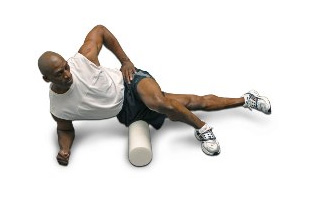
Figure 1 (above) - view exercise
Foam roll the outside of the upper leg.
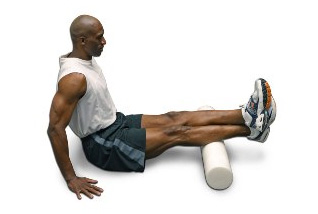
Figure 2 - view exercise
Foam roll the calves.
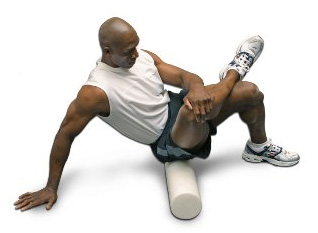
Figure 3 - view exercise
Foam roll the piriformis (the small muscle that lies beneath the glutes and turns your leg out).
After foam rolling, try some stretches to loosen your muscles up for your run. There are many types of stretches, but to prepare for a run, try some active stretching. These types of stretches both loosen you up and warm up your brain to activate the right muscles at the right times to help you move more efficiently. Try the stretches shown below:
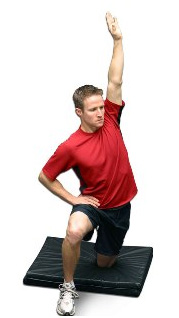
Figure 4 - view exercise
This active stretch will help loosen up your hips. Hold the end stretch position for 2-4 seconds and repeat 5-10 times.
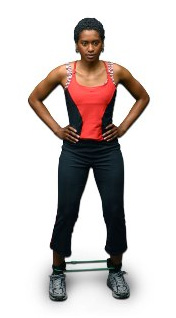
Figure 5 - view exercise
Take 10 steps to the right and 10 steps to the left. This active stretch will help loosen up the muscles on the inside of your leg that are generally tight, and help those glutes start firing!
Your warm-up should also include some activity that raises your heart rate. Walking, push-ups, or even squats will help elevate your core temperature.
Some Tips on the Run
• Choose a path to run and change it every couple of days. It is always a good idea to plan a route that you feel comfortable running. The path you choose should fit your level of ability. It is tempting to want to challenge yourself right away, but work up to the harder paths. This will help increase motivation and decrease frustration from not being able to finish your run. By changing your route, you may increase stimulation and decrease the chance of boredom. Motivation during runs is key, so find a path you like and determine why you like it (e.g., it’s full of trees, ocean air, etc.) so you can find other paths with the same stimulation to motivate you.
• No matter how long or how hard the run is, always cool yourself down. Going for a good run can feel extraordinary, but if you choose to skip the cool-down, over time, that run won’t feel as great. A good cool-down should bring the body down to a steady state of rest. Here are some tips to incorporate into your cool-down:
• Walk an extra 10 minutes after your run. Running can be intense, so walking helps the body calm down.
• Incorporate static stretches to return muscles to their optimum lengths. Muscles tend to get tight from overuse or repeated activity. Static stretching can help lengthen the muscles you used during the run and, in the end, may help guard against future injuries. Static stretching is when you hold a stretched position for 20-30 seconds. Below is a list of a few key stretches for runners:
Figure 6 — Hip Flexor Stretch - view exercise
1. Kneel on the left leg with the right leg bent.
2. Draw your bellybutton toward your spine and tilt your pelvis underneath you (tuck your tail).
3. Raise your left arm and reach up as though you are asking a question.
4. With your arm in the air, lean to your right side, and then slightly turn your body to your left.
5. Hold the end position for 30 seconds.
6. Repeat on the opposite side.
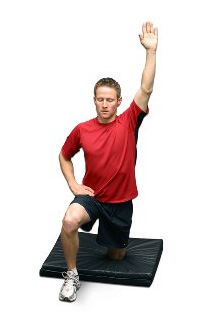
Figure 7 — Calf Stretch - view exercise (seen with external support)
1. Place your right foot slightly behind your left, in a staggered stance, as shown.
2. Keep your feet facing straight ahead (if your feet were on the face of a clock, the pointy part of your sneaker should point to 12).
3. Draw your bellybutton in towards your spine and tuck your pelvis under.
4. Tighten the muscles in the front of your thigh and in your butt.
5. If necessary, lean on an external support, but do not lose good posture.
6. Hold the position for 30 seconds.
7. Repeat on the opposite side.
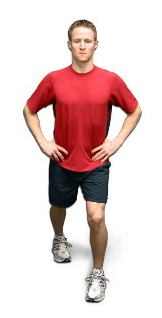
Figure 8 — Latissimus Dorsi* Stretch - view exercise
1. Get down on the floor in a table top position.
2. Place your left arm on top of the ball with your thumb pointing up to the sky.
3. Keep your head and upper back straight, draw your bellybutton in towards your spine, and tuck your pelvis under (tuck your tail).
4. Reach your arm across your body (do not lose good posture) and hold there for 30 seconds.
5. Repeat on the opposite side.
* The biggest muscle of the back.
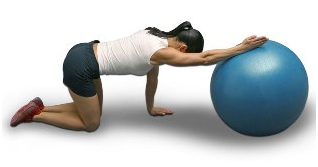
In Conclusion
If you want it to be, running can be a great calorie-burner and stress-reliever. Just remember these key tips, and you will be a successful runner, enjoying the many benefits of getting out there and moving towards a healthier tomorrow. Have a great run!